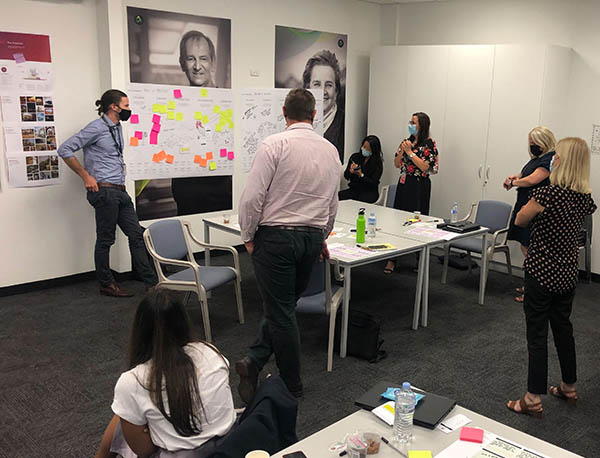 Read time: 3 minutes
Read time: 3 minutes
Co-design in the built environment is more than consultation – it involves having equal seats at the table for consumers, end-users, service providers and design professionals, facilitated by trained professionals in social cohesion and co-design methodologies.
Page contents:
Through a co-design methodology, the content, services, facilities, program and built form are delivered by moving away from designing services for people, instead delivering buildings and places with services and programs designed with people. It is a more human focused way of delivering cohesive, inclusive architecture that ultimately supports better decision making, and therefore reduces risk, in community-making projects.
Process
Co-design creates equal engagement between stakeholders – such as ‘residents, customers, employees, vendors, suppliers, communities and government bodies’ (AACA 2021) – and design professionals by the sharing and valuing of knowledge and different lived experiences and perspectives. It can contribute to more considered places, programs and outcomes for all — changing the stakeholder-designer relationship from designing for people, to designing with people.
Co-design brings relevant stakeholders and the design team together to understand the issues from a range of perspectives and design actionable ways to deliver places, services and policies that better meet the needs of people in/or affected by the design. Co-design is effective in all sectors, but currently is most seen in the healthcare, transport and public realm sectors due to the number of engaged and relevant stakeholders delivering services.
By giving equal voice to all those affected in the design, the entire team move from being informants to being active participants, contributors, and collaborators, which can advocate for meaningful impact on the outcomes of the services, programs and social infrastructure that inform the built form.
Co-design and co-production
Co-design and co-production are often interchangeably used incorrectly. In both, the people using or affected by the built environment have equal voice and responsibility in achieving positive change and improved outcomes. The key difference between co-design and co-production is centred around the level of responsibility. Co-production features relevant stakeholders as shared decision-makers. Co-design features relevant stakeholders having strong influence on the decision-making process. Co-design tends to precede co-production, but both are part of a ‘co’ mindset to project value creation and delivery.
Many companies and service providers aim to engage in co-design, recognising that co-production may not always be possible as often key decisions are made by external agencies, authorities, government departments and law makers.
Co-design is a critical step towards co-production. It brings consumers and many different stakeholders together to understand the issues from a range of perspectives and design meaningful ways to deliver places, services and policies that meet the needs of end-users who will live, work or play in the built environment.
Benefits
- Co-design brings all relevant stakeholders into the room with equal power to affect the outcomes.
- Services, and in turn, the built form have more resolved design solutions.
- End-users have more ownership and advocacy over the built form and services.
- End-users are more connected to the building/place and each other.
- All participants feel respected and consulted.
- Stakeholders feel empowered to raise their issues and suggestions to inform outcomes.
- Structured frameworks and agendas need to be in place before moving into co-design to ensure protocols and reiteration processes are established.
- A safe space to ask questions and raise issues needs to be made and maintained.
- Complex architectural terms are replaced with unassuming language, with a focus on people’s needs or social needs as outcomes.
Challenges
- Having many voices at the table can be an additional challenge for the project leads and architects to assess and interpret how to integrate important issues in the design, therefore engagement of an experienced co-design facilitator is imperative.
- It can be difficult to reach resolution if the co-design process is not designed and facilitated well.
- It takes time and is best scheduled before work has commenced, which needs allowance for.
- Designers need to invest attention, time and energy in the stories and lived experiences of the co-design stakeholders to understand the building and/or place requirements more thoroughly.
- Including First Nations and Indigenous perspectives in co-design for the built environment process is an emerging area and needs extra focus and specialisation.
References
- Architects Accreditation Council of Australia (ACAA) (2021) National Standard of Competency for Architects 2021 explanatory notes and definitions [PDF], ACAA website.
Disclaimer
This content is provided by the Australian Institute of Architects for reference purposes and as general guidance. It does not take into account specific circumstances and should not be relied on in that way. It is not legal, financial, insurance, or other advice and you should seek independent verification or advice before relying on this content in circumstances where loss or damage may result. The Institute endeavours to publish content that is accurate at the time it is published, but does not accept responsibility for content that may or has become inaccurate over time. Using this website and content is subject to the Acumen User Licence.
